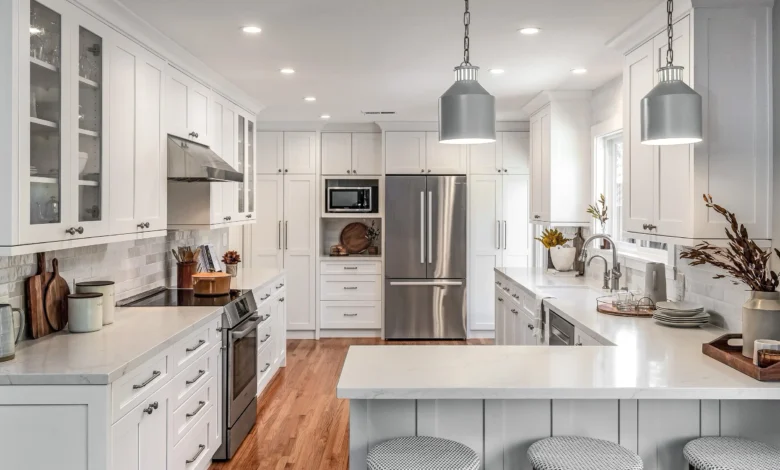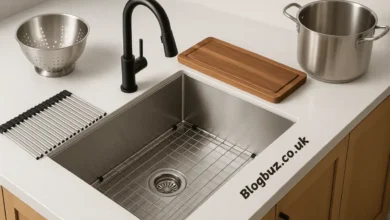Kitchen Remodeling: Transforming the Heart of Your Home

The kitchen is more than just a place to cook—it’s the heart of your home. It’s where families gather, conversations flow, and memories are made. Over time, however, even the most beloved kitchens can begin to show signs of wear or feel outdated. That’s where kitchen remodeling comes in.
A well-executed kitchen remodel not only improves functionality and aesthetics but also significantly boosts your home’s value. Whether you’re envisioning a sleek modern layout, a cozy farmhouse style, or simply a more efficient workspace, remodeling your kitchen offers both practical and emotional rewards.
In this comprehensive guide, we’ll explore everything you need to know about kitchen remodeling—from planning and design to budgeting, material choices, and hiring the right professionals.
Why Kitchen Remodeling Is Worth the Investment
Homeowners often cite the kitchen as the one room they would most like to upgrade—and for good reason. Remodeling your kitchen is a smart investment that can yield both personal satisfaction and financial returns.
1. Enhanced Functionality
Older kitchens often lack the space, layout, or features to support modern lifestyles. A remodel can improve workflow, add storage, and integrate new appliances and smart technologies.
2. Increased Home Value
Kitchen upgrades consistently rank among the top home improvements for return on investment. Even a minor kitchen remodel can recoup a significant percentage of its cost at resale.
3. Improved Energy Efficiency
Replacing outdated appliances, installing LED lighting, and choosing energy-efficient windows or ventilation systems can lower utility bills and reduce environmental impact.
4. Updated Style
Tastes change. Remodeling allows you to bring your kitchen up to date with current trends, materials, and finishes that reflect your personal style.
5. Better Use of Space
Remodeling provides an opportunity to rethink the kitchen layout, creating an open-concept design, island seating, or better access to adjoining rooms.
Planning Your Kitchen Remodel: Where to Start
Before selecting countertops or browsing tile samples, you’ll need a clear plan. A successful kitchen remodel begins with thoughtful preparation.
1. Assess Your Needs
Ask yourself:
- How do you use your kitchen now?
- What frustrates you about the current layout?
- Do you need more seating, storage, or counter space?
- Is this a cosmetic update or a full structural change?
Understanding your needs sets the stage for every decision that follows.
2. Set a Realistic Budget
Kitchen remodels can range from a few thousand dollars for simple updates to well over six figures for high-end overhauls. Consider:
- Scope of work (minor facelift vs. full renovation)
- Appliance upgrades
- Material choices
- Labor costs
- Contingency funds (10–20% of your budget for unexpected issues)
A clear budget helps you prioritize features and avoid surprises.
3. Create a Design Vision
Collect inspiration from magazines, online galleries, or home improvement apps. Define your preferred style—modern, traditional, rustic, industrial, minimalist, or something in between.
Then, consider how it fits with the rest of your home’s design.
4. Hire the Right Team
Depending on the complexity, you may need:
- A general contractor
- Kitchen designer
- Architect (for structural changes)
- Electricians and plumbers
- Cabinetmakers and tilers
Look for licensed, insured professionals with proven experience in kitchen remodeling.
Key Elements of a Kitchen Remodel
Each part of your kitchen contributes to its function and appearance. Let’s break down the primary components:
1. Cabinetry
Cabinets are often the largest expense in a kitchen remodel. Options include:
- Stock cabinets: Pre-manufactured and budget-friendly
- Semi-custom cabinets: Allow moderate personalization
- Custom cabinets: Fully tailored to your space and style
Consider storage features like pull-out shelves, lazy Susans, or hidden trash bins.
2. Countertops
Countertops are both functional and focal. Popular materials include:
- Granite: Durable, natural stone with unique patterns
- Quartz: Engineered stone, non-porous and low maintenance
- Marble: Elegant but high maintenance
- Butcher Block: Warm, affordable, and ideal for prep areas
- Concrete or stainless steel: Sleek and modern
Choose a material that balances style, usage, and upkeep.
3. Flooring
Kitchens demand floors that can withstand moisture, heat, and traffic. Top choices:
- Tile: Durable and easy to clean
- Luxury vinyl plank (LVP): Water-resistant and cost-effective
- Hardwood: Classic appeal, though prone to scratches
- Laminate: Budget-friendly alternative to wood or stone
4. Lighting
Good lighting is essential for safety and ambiance. Layer your lighting with:
- Ambient: Ceiling fixtures or recessed lighting
- Task: Under-cabinet or pendant lighting for prep areas
- Accent: Decorative lighting for visual interest
LED lighting is both energy-efficient and long-lasting.
5. Backsplash
The backsplash protects your walls and offers a chance to introduce color or texture. Options include:
Subway tile
Mosaic
Glass panels
Stone veneer
Metal or mirrored finishes
A kitchen mirrored backsplash can also create a sense of depth and brightness by reflecting light throughout the room, making smaller kitchens appear more spacious and elegant.
6. Appliances
New appliances can improve functionality and efficiency. Popular upgrades:
- Induction cooktops
- Double ovens
- Smart refrigerators
- Drawer-style microwaves
- Quiet dishwashers
Choose appliances that fit your lifestyle and integrate with your cabinetry design.
Layout Considerations
Your kitchen layout is the foundation of a functional design. Here are the most common configurations:
• Galley Kitchen
Efficient for small spaces, with two parallel countertops.
• L-Shaped Kitchen
Maximizes corner space and opens to adjacent rooms.
• U-Shaped Kitchen
Offers plenty of counter and storage space for large kitchens.
• Island Kitchen
Adds workspace and seating, ideal for entertaining and multitasking.
• Open-Concept Kitchen
Integrates with living or dining areas, enhancing flow and social interaction.
When planning your layout, consider the “kitchen work triangle”—the optimal distance between the sink, stove, and refrigerator.
Trends in Kitchen Remodeling
Design trends evolve constantly, but some innovations are here to stay:
✅ Open Shelving
A popular alternative to upper cabinets, providing a light, airy look.
✅ Two-Tone Cabinets
Combining light and dark tones for depth and contrast.
✅ Quartz Countertops
Low maintenance and stylish, quartz continues to dominate.
✅ Smart Technology
Voice-controlled lighting, connected ovens, and app-managed refrigerators add modern convenience.
✅ Matte Finishes
Sleek, fingerprint-resistant surfaces in cabinetry and appliances.
✅ Eco-Friendly Materials
Reclaimed wood, recycled glass countertops, and low-VOC paints promote sustainability.
While it’s great to be inspired by trends, prioritize choices that reflect your personal taste and long-term satisfaction.
Kitchen Remodeling Mistakes to Avoid
Even small missteps can derail your kitchen remodel. Here are common pitfalls to watch for:
- Neglecting ventilation: A good range hood prevents odors, grease, and moisture buildup.
- Choosing form over function: Stylish designs that ignore practicality often lead to regrets.
- Underestimating storage: More storage is always better, especially in high-use zones.
- Skipping a contingency fund: Hidden plumbing or electrical issues can emerge during demolition.
- DIYing complex tasks: Electrical, plumbing, and structural changes require professionals.
Avoiding these mistakes will help your project run more smoothly and deliver better results.
Is Professional Kitchen Remodeling Worth It?
While DIY projects can save money, professional kitchen remodeling services provide experience, craftsmanship, and efficiency. Here’s why many homeowners opt for experts:
- Design expertise ensures smart layouts and aesthetic harmony.
- Project management keeps the timeline and budget on track.
- Access to premium materials and trades that might be unavailable to DIYers.
- Code compliance and permits handled properly.
If you’re making significant structural changes or investing heavily in materials and finishes, a professional remodel is almost always worth the investment.
Final Thoughts
Your kitchen should reflect who you are—both in style and functionality. Whether you want to enhance efficiency, update aesthetics, or increase your home’s value, Kitchen Remodeling offers a unique opportunity to reimagine one of your home’s most essential spaces.
With the right planning, team, and design, your dream kitchen is more achievable than ever. So take the first step: visualize your ideal space, set your goals, and begin the rewarding journey toward a kitchen that truly works for you.



